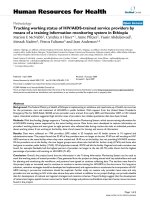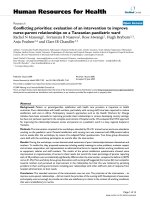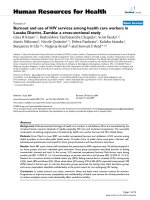báo cáo sinh học:" Sustainable scaling up of good quality health worker education for tuberculosis control in Indonesia: a case study" doc
Bạn đang xem bản rút gọn của tài liệu. Xem và tải ngay bản đầy đủ của tài liệu tại đây (390.15 KB, 9 trang )
BioMed Central
Page 1 of 9
(page number not for citation purposes)
Human Resources for Health
Open Access
Research
Sustainable scaling up of good quality health worker education for
tuberculosis control in Indonesia: a case study
Carmelia Basri
1
, Karin Bergström*
2
, Wanda Walton
3
, Asik Surya
1
,
Jan Voskens
4
and Firdosi Metha
5
Address:
1
National Tuberculosis Control Programme, Ministry of Health, Jakarta, Indonesia,
2
Tuberculosis Strategy and Operations, Stop TB
Department, World Health Organization, Geneva, Switzerland,
3
Division of Tuberculosis Elimination, Centers for Disease Control and
Prevention, Atlanta, GA, USA,
4
KNCV, The Hague, Netherlands and
5
World Health Organization, Jakarta, Indonesia
Email: Carmelia Basri - ; Karin Bergström* - ; Wanda Walton - ;
Asik Surya - ; Jan Voskens - ; Firdosi Metha -
* Corresponding author
Abstract
Background: In 2000, an external review mission of the National Tuberculosis Control
Programme of Indonesia identified suboptimal results of TB control activities. This led to a
prioritization on human resource capacity building representing a major shift in the approach
following the recommendations of the external review team.
Case description: The National Tuberculosis Control Programme (NTP) used a systematic
process to develop and implement two strategic action plans focussing on competence
development based on specific job descriptions. The approach was a change from only focussing
on training, to a broader, long term approach to human resource development for comprehensive
TB control.
A structured plan for capacity building, including standardized competency based training modules
and curricula, was developed in the first phase. This was supported by an organisational system
comprised of a training focal point, master trainers, and regional training centres in which
nationwide training of supervisors was implemented. Training was expanded to the health service
delivery level in the second phase, as well as broadened in the scope of activities beyond training
to also include other aspects of human resource development.
Discussion and evaluation: The result was improved technical and managerial capacity of health
workers for TB control at all levels. The impact on case detection and treatment outcome was
spectacular, with major improvements in quality of all aspects of service delivery.
Conclusion: The strategic decision by the NTP in 2000 to put the highest priority on capacity
building has resulted in impressive progress towards TB control targets, a progress that despite
many challenges has been sustained.
Published: 16 November 2009
Human Resources for Health 2009, 7:85 doi:10.1186/1478-4491-7-85
Received: 28 January 2008
Accepted: 16 November 2009
This article is available from: />© 2009 Basri et al; licensee BioMed Central Ltd.
This is an Open Access article distributed under the terms of the Creative Commons Attribution License ( />),
which permits unrestricted use, distribution, and reproduction in any medium, provided the original work is properly cited.
Human Resources for Health 2009, 7:85 />Page 2 of 9
(page number not for citation purposes)
Background
Indonesia ranks third in tuberculosis (TB) burden in the
world with an estimated annual incidence of 239 cases per
100 000 people (108 sputum smear positive [ss+] cases
per 100 000 people per year) and an estimated prevalence
of 262 cases per 100 000 people [1]. DOTS, the TB control
strategy recommended by the World Health Organization
(WHO) [2], was introduced in Indonesia in 1992 with
combined tuberculosis-leprosy pilot projects in four
Sulawesi provinces (supported by KNCV Tuberculosis
Foundation [KNCV] and Nederland's Leprosy Relief
[NLR]). Initial trials achieved high cure and success rates.
In 1995, WHO declared a TB emergency in the country.
This led to the adaptation of the DOTS strategy in 1995,
with the gradual expansion to all provinces. This expan-
sion however, resulted in inappropriate implementation
in some areas with detrimental results to the quality of the
programme.
In February 2000, a review of the National Tuberculosis
Control Programme (NTP) of Indonesia was conducted
with the assistance of WHO and KNCV. The review mis-
sion concluded that all five basic elements of the DOTS
strategy appeared to be weak, except for the political com-
mitment at national level, as demonstrated by the estab-
lishment of the Gerdunas (i.e., the national Stop TB
Partnership) in 1999. Programme expansion had been
too rapid and ambitious, without adequate preparation
such as training and supervision of district staff. As a con-
sequence, results for case detection were well below expec-
tations. The case detection rate (CDR) for new sputum
smear positive pulmonary TB was 19%, while the treat-
ment success of these new sputum smear positive cases
was 87.4%. The mission also concluded that many opera-
tional problems were caused by shortcomings in technical
and management capacity at all levels of the health serv-
ices, especially with regard to manpower, equipment,
supervision, logistics, health information systems, and
planning. This was due to suboptimal quality of training
conducted in the past. Training was hampered by lack of
planning, scant budget allocations, no standardized cur-
ricula, deficient training material, shortage of competent
trainers, inadequate teaching methods and evaluations, as
well as lack of follow-up. Problems were further compli-
cated by the erratic distribution of anti-TB drugs since
1999, which led to the unavailability of drugs in many
districts. A considerable backlog in training was identi-
fied; additionally, several provinces reported a problem of
trained staff being transferred to other places.
With relation to capacity building, the review team recom-
mended that the training backlog should be immediately
addressed. This included a detailed analysis of the current
training needs and development of a comprehensive
training plan within the following 3 months. The team
also recommended that attention to quality assurance
should also be in place. The overall capacity at provincial
and district levels in terms of manpower, supervision, and
training should be strengthened. Following the review
mission, the NTP granted capacity building the highest
priority and radically revised methodologies and
approaches used in their human resource development
activities as part of gradual programme strengthening. We
report on this strategic development of the human
resources involved in the NTP in the period 2000-2006,
following the recommendations of the review mission in
2000, and the results of these activities. It should be noted
that this was not a pilot project, but part of routine pro-
gramme management by the Ministry of Health.
Case description
The systematic development of capacity in the NTP can be
divided into two phases: The 2000 - 2002 "Plan to build
capacity" and the 2003-2006 "HRD-TB strategic plan for
the NTP, Indonesia". In the first phase, the focus was put
on developing a structured system for providing training
of high quality, both technically and educationally. In the
second phase, the focus was on implementation, scaling-
up, quality control, and addressing new human resources
development (HRD) challenges as the progress towards
TB control targets started accelerating.
2000-2002: Plan to build capacity
Following the review mission in 2000, the NTP undertook
a problem analysis of the NTP capacity including rapid
assessment of the human resources and training situation.
The findings confirmed the observations made by the
external review mission. Based on this, the NTP decided to
do a complete restructuring of all training activities fol-
lowing strategic, competency based methodologies and
accepted educational standards [3]. A comprehensive
plan for capacity building in the NTP was developed for
the period 2000-2002, followed by a project proposal for
funding of the plan. The funding proposal was approved
by the Dutch government. The overall goal of the plan was
to improve the quality of the services delivered to TB
patients through improvement of the skills of health
workers at the various levels; a secondary goal was to
improve the efficiency and cost-effectiveness of TB control
programme management. To achieve this, it was also nec-
essary to strengthen the intermediate and central levels of
the program. It was expected that the range of interven-
tions would improve the quality of performance at the
service delivery level. The plan included the following
areas of intervention (or methods) related to capacity
building:
Human Resources for Health 2009, 7:85 />Page 3 of 9
(page number not for citation purposes)
1. Development of a training plan outlining specific strat-
egies, revised or updated job descriptions, and standard-
ized training material and curricula.
2. Development of a national resource group ('master
trainers') for the strengthening of management capacity.
3. Development of provincial/district TB management
and training teams.
4. Training of health service units (UPK).
5. Training of hospital staff and private practitioners.
6. Inclusion of TB case management in pre-service training
curricula.
1. Development of a training plan outlining specific strategies, revised
or updated job descriptions, and standardized training material and
curricula
The TB control central unit was strengthened by appoint-
ing additional staff sub-contracted with funding provided
by the external donor. A training plan was developed. The
priority was the rapid training of approximately 60% of
supervisory staff at provincial and district levels. Approxi-
mately 850 supervisors were estimated in need of training.
At service delivery level, the training need was even
greater, with more than 7300 health centres with nurses
and doctors involved in TB control. Given the training
backlog, the high numbers of staff requiring training, and
the urgent need of skilled staff, the approach used was
stepwise cascade training (Figure 1). This model involved
initial training of selected staff at central level, empower-
ing them to become trainers themselves and to be actively
involved in the training of staff in the following imple-
mentation tier; staff in each tier were then selected and
capacitated to train staff in the implementation tiers
below. Prior to training, a specific training curriculum for
each level was developed. The NTP (supported by KNCV
and WHO) reviewed the national TB guidelines and gen-
erated updated job descriptions for all staff involved in
DOTS implementation. Job descriptions were based on
the task analysis of activities required for appropriate
DOTS implementation and were used to develop specific
training curricula for staff at each level (master trainers,
provincial and district supervisors, health centre doctors,
nurses and laboratory technicians). The Central Unit of
the NTP established a human resource working group rep-
resenting all stakeholders. This group developed a set of
ten competency based, basic modules for training provin-
cial and district supervisors and staff at health centre level
(Appendix 1). Additional modules were developed for
training master trainers and course directors, as well as
course facilitator guides. The course director and course
facilitator guides included checklists to facilitate the plan-
ning and preparation of provincial and district training
activities, and guidance for quality assurance of training
courses. The training methodology included an ongoing
assessment of participants through exercises, discussions,
and observations.
2. Development of a national resource group ("master trainers") for
the strengthening of management capacity
The first step was the establishment of a master training
committee. This committee was charged with the task of
recruiting master trainers based on strict selection criteria,
organizing the initial training course for master trainers,
following-up on activities after this training (including
regional planning meetings), and advising on the selec-
tion of four Regional Training Coordinators leading the
regional teams of master trainers. Twenty-nine individu-
als from all over the country, including 23 individuals
from the provinces and six from hospital settings (lung
clinics) were identified and trained in the first training
course for master trainers. The course included the full set
of basic TB modules and lasted nine weeks. this included
three weeks for the modules, four weeks for field exercises
and assessment of training needs, one week for training
skills development, and a final week for planning of
regional trainings and other important health issues
related to TB, such as HIV and leprosy. Training method-
ologies were based on competency development methods
and methodologies; it included active participation meth-
ods, problem-based learning, and motivation techniques.
Twenty-six trainers completed the course; from this group,
four Regional Training Coordinators and a National
Training Coordinator were selected and appointed. Mas-
ter trainers became full time NTP employees and were
Cascade trainingFigure 1
Cascade training. NTP: National Tuberculosis Control
Programme. NTC: National training coordinator. PTC: Pro-
vincial training coordinator. HRD: Human resource develop-
ment. TOT: Training of trainers.
Master trainers
RTC RTC RTC RTC
PTT
PTT
PTT
PTT
PTT
PTT
PTT
PTT
PTT
PTT
PTT
PTT
Health service unit (health centers, lung clinics, hospitals, etc.)
NTC as HRD
focal point
4 Regional
Training
Center (RTC)
for TOT
PTC as
HRD
focal point
NTP Manager
Provincial
Training
Team (PTT)
and
Supervisors
Curricula,
modules,
facilitator and
training guide
Human Resources for Health 2009, 7:85 />Page 4 of 9
(page number not for citation purposes)
posted to the four regional training centres covering all 30
provinces (Table 1), with five to seven master trainers per
training centre.
3. Development of provincial/district TB management and training
teams
From April 2001 to February 2002, master trainers at the
four regional training centres worked full time to train
provincial and district supervisors. Approximately 25
supervisors were enrolled in each training course, divided
in four to five groups per batch, keeping the targeted ratio
of five trainees per trainer. The curriculum included all ten
core training modules (Appendix 1), supplemented with
field visits and practical work The training lasted for 14
working days. Master trainers established criteria for the
selection of provincial and district trainers from the
trained supervisors. Selection was made in coordination
with regional master trainers and local health authorities.
Provincial and district trainers were trained together, and
became the teams that trained the staff from the health
service units (UPK) and hospitals. Master trainers were
continuously involved in the training of district staff;
however, they gradually delegated training to provincial
and district staff while providing direct supervision to
ensure quality of district training.
The location of provincial/district training was selected
carefully, to ensure it occurred in areas where the DOTS
strategy had been implemented well. These districts
served as 'centres of excellence', becoming examples for
other districts. After successful completion of the course,
the trainees received a course certificate. Trainees who
were identified as potential trainers received a special cer-
tificate stating their potential of becoming a trainer for
health centre level staff.
4. Training of health centre level staff (UPK)
Training for staff at the health centre level started in March
2002. The courses for doctors and nurses took five work-
ing days to complete and included six training modules
(modules 1 and 2, parts of module 3, and modules 4, 6
and 8). Training for laboratory technicians took nine days
and included four modules (selected parts of modules 1
and 2, module 3 and parts of module 9). Post training
evaluation was carried out at health centre level during
regular supervisory visits to monitor the quality of the
training process, identify shortcomings, and to provide
feed back to the regional training centre.
5. Training of hospital staff and private practitioners
The initial assessment had identified hospital staff and
private practitioners as a key target group for capacity
development for the implementation of the DOTS strat-
egy. According to the plan, provincial/district training
teams were going to train hospital doctors and nurses,
together with private practitioners, in two-day seminars.
To disseminate knowledge and skills, trained health unit
doctors were to organize one day 'micro symposia' on TB/
leprosy and HIV for all non designated staff in their health
service units. Hospital managers were to be invited for
one-day seminars to disseminate and discuss NTP guide-
lines. However, it was found that training curriculum and
materials needed adaptation to suit the needs for these
specific providers. In particular, the specific characteristics
of hospital set-up and referral mechanisms between these
providers and general health services needed to be cov-
ered in the training program.
6. Inclusion of TB case management in pre-service training curricula
The plan included activities to initiate the process to
update curricula in national and private training institu-
tions, to be in line with national guidelines for TB control,
to ensure the long term sustainability of competences for
all health workers involved in TB control. Co-ordination
between the Gerdunas (i.e., the National Stop TB Partner-
ship) and the national government training institutions
was to be improved through seminars at provincial level,
starting in 2001. Gerdunas were to produce and dissemi-
nate the NTP case management guidelines to the training
institutions, which were expected to incorporate the NTP
case management guidelines into their curricula. How-
ever, activities were delayed and in the 2000-2002 period
only a first workshop was held with representatives of
medical training schools.
2002-2006: HRD-TB strategic plan for the NTP Indonesia
The HRD-TB strategic plan was developed as a continua-
tion of the 2-year capacity building plan, built on the
foundation and results of this first plan, and was part of
the NTP's overall 5-year strategic plan for DOTS expan-
sion. Funding for this plan was initially made available
through United States Agency for International Develop-
Table 1: Regional training centres
Centre Region Number of Master Trainer Provinces covered°
Padang West Sumatra 6 8 provinces in the west
Makasar South Sulawesi 5 10 provinces in the north and east
Murna Jati East Java 6 6 central provinces
Ciloto West Java 7 6 provinces in the west
Human Resources for Health 2009, 7:85 />Page 5 of 9
(page number not for citation purposes)
ment (USAID) and Canadian International Development
Agency (CIDA). Later funding was through the Global
Fund for Aids, Tuberculosis and Malaria (GFATM, now
GF). A long term approach was taken to training and other
activities for human resource development. This repre-
sented a shift from a 'training only' focus to a broader stra-
tegic approach to HRD, thus representing a paradigm shift
within the NTP [4]. This also represented a shift towards a
stronger role for long term, comprehensive management
of HRD at all levels.
The overall strategic goal in the plan for HRD was to
ensure that all staff involved in TB control at all levels had
the appropriate skills, and that there was enough staff at
the right time, to support programme implementation to
reach the TB control goals of the programme. Operational
policies and strategies were developed to achieve this goal;
specific targets were set with regards to (i) availability of
trained staff for TB control at the health centre, district and
provincial level; (ii) availability of trained staff for TB con-
trol for hospitals; and (iii) the development of a TB com-
ponent for the curricula in basic training institutions. The
key activities listed in the plan were: continue to develop
and revise (as necessary) training guidelines, curricula and
modules for both pre- and in-service training and educa-
tion; conduct training needs assessments; ensure annual
planning for TB-HRD at all levels; supervise and monitor
the implementation for these plans; and develop an infor-
mation system for monitoring the availability of trained
staff at various levels.
Discussion and evaluation
The results are presented in two sections: the first section
describes the capacity development activities towards the
goal as outlined in the HRD strategic plan; the second sec-
tion describes the impact of the capacity development
activities on progress towards national and global TB con-
trol targets (5,6)
Capacity development
A structured training system with standardized, compe-
tency based training modules, curricula, master trainers,
and regional training centres was developed (Figure 2). A
total of 991 provincial and district supervisors were
trained during the first 15 months of the implementation
of the training activities. Due to staff turnover (attrition as
a consequence of de-concentration and health sector
reforms implemented in 2001) and some confusion
regarding selection criteria, more than one supervisor per
district and province were trained. In 2003, training was
provided for 333 recently appointed supervisors, all of
them filling positions left by previously trained supervi-
sors who were transferred to work in other positions out-
side the TB control program.
Training of doctors, nurses, and laboratory technicians at
health centre level started in March 2002. By the end of
2002, training had been provided for about 35% of the
doctors and nurses (2500), and for 38% (1000) of the lab-
oratory technicians. The training of health centre staff was
delayed due to organizational limitations during rapid
scaling up of training. Staff turnover of around 10-20%
per year further slowed down the efforts to increase the
availability of competent staff at this level.
By late 2004, an information system, including staffing
standards, had been established that allowed the monitor-
ing of availability of trained staff by health facility, espe-
cially at health centre level (Figure 3). In 2003, a full-time
National Training Coordinator (NTC) was appointed at
the central level of the NTP, Additionally, terms of refer-
ence were developed to strengthen the management of
training activities and co-ordinate activities nationally. In
the same year, 30 Provincial Training Coordinators (PTC)
were appointed. However, due to the 'zero growth' policy
of the Ministry of Health, this did not represent new
appointments but rather the creation of an additional role
to previously employed staff or the recognition of previ-
ously ad hoc performed activities. The role of the PTC was
to plan, organise, and monitor training at province level
in the efforts to accelerate capacity building. The central
team was further strengthened with additional contracted
staff; and at provincial level, Provincial Project Officers
(PPO) were appointed.
Training organizationFigure 2
Training organization. DG CDC & EH: Director-general,
Disease Control and Environmental Health. NTP: National
Tuberculosis Control Programme. PMU: Programme Man-
agement Unit. PPO: Provincial Project Officer.
DG CDC&EH
NTP MANAGER
NATIONAL TRAINING COORDINATOR (TC)
TECHNICAL SUPPORT
TEAM
PMU
MANAGEMENT FACILITATORTRAINING CENTER
TRAINING
MANAGEMENT
FACILITATOR
TC
TARGET (TRAINEE)
PROVINCIAL TRAINING COORDINATOR
PROVINCIAL TB MANAGER
TRAINING TEAM
PPO
CENTRAL
PROVINCE
Human Resources for Health 2009, 7:85 />Page 6 of 9
(page number not for citation purposes)
In 2004, post-graduate training began for senior program
staff through the advanced course for supervisors on
DOTS acceleration (ACDA) to further strengthen techni-
cal and managerial skills of selected central staff and pro-
vincial supervisors. This course was a modification of an
international training course curriculum adapted to the
Indonesian situation.
A system was developed to strengthen training evaluation
to further improve quality (Figure 4). Involvement of the
lung clinics started with sensitization of managers, fol-
lowed by a one-week training of medical staff. Gradually,
the involvement further expanded to include both public
and private hospitals. By 2004, all 34 lung hospitals and
lung clinics in the country, in addition to an estimated
20% of all public and private hospitals, had become
involved in the national DOTS program.
A new competency-based curriculum for medical schools
was developed; introduction in medical faculties was
started in a phased manner after extensive consultations.
Introduction of DOTS in nursing schools started in 2003,
and is now being implemented in 18 schools.
Progress towards TB control targets
A rapid increase in case detection rates was observed in
provinces after the training of health centre staff, whereas
neighbouring provinces with low levels of training
showed slow progress. This increase took place before
external donor support (USAID, CIDA, GFATM) was
stepped up. Case notification of all types of TB and new
smear positive pulmonary TB increased from 84 591 to
285 030, and from 52 338 to 174 953 respectively in the
period 2000-2006 (Table 2) [5,6]. This represented an
increase in the case detection rate for new smear positive
Percentage of health center staff trained to standard, by province, Indonesia, mid 2005Figure 3
Percentage of health center staff trained to standard, by province, Indonesia, mid 2005. % Trained to standard.
< 50%
50 – 80%
81 – 100%
> 100%
Medical doctors
Paramedics
Lab technician
Human Resources for Health 2009, 7:85 />Page 7 of 9
(page number not for citation purposes)
TB from 19% in 2000, to 54% in 2004 and 76% in 2006
(Figure 5) [5]. Treatment success rates were sustained at
over 85% over the same period, and achieved 89% success
for the 2004 cohort [5]. Major improvements were also
made in each category of treatment outcome, representing
a major quality improvement in programme implementa-
tion (Figure 6).
Discussion
During the period of 2000 - 2006, remarkable progress
was made in building technical and managerial capacity
for TB control at all levels within the health system. This
had a direct effect on program performance, particularly
on all aspects of TB case management, TB case notifica-
tion, and the quality of surveillance. Management for
HRD at the central level, and various other levels of the
health system, was strengthened with the responsibilities
for HRD clearly established. This illustrates the impor-
tance accorded to HRD activities within the NTP.
Much effort was put into building a management system
for capacity building, the training of the national master
trainers, and the development of the basic training mod-
ules, thereby constructing a solid basis for subsequent
expansion. At health centre level, there was a significant
improvement of skills in DOTS implementation. This
included laboratory performance and compliance with
NTP guidelines. However, the high staff turnover, espe-
cially at the health centre level, complicated and delayed
progress. Furthermore, at the health centre level, the work-
load for nurses is often high due to tasks and responsibil-
ities other than TB control. The training of district and
provincial supervisors led to improved supervision which
contributed to improved motivation and performance.
These regular supervisory visits, including, but not limited
to, data collection are key to quality improvement and
sustainability.
A key factor to the success was the appointment of a focal
person for HRD, the NTC, within central level NTP, as
well as the systematic approach to establishing an organi-
zational structure at all levels for HRD and the standardi-
zation of training materials and procedures. The
importance of having the HRD focal person located at the
central unit to facilitate close collaboration with all mem-
Methods for training evaluationFigure 4
Methods for training evaluation.
DURING TRAINING POST TRAINING
REACTION
EVALUATION
LEARNING EVALUATION
PERFORMANCE
EVALUATION
IMPACT
EVALUATION
PARTICIPANT
FACILITATOR
TRAINING TEAM / COMMITTE
SUPERVISOR RESEARCHER
TRAINING COORDINATOR
MODEL /TYPE
OF
EVALUATION
BY WHO
TIME
DURING TRAINING
3 – 6 MONTHS POST
TRAINING,
INTEGRATED TO
SUPERVISION
ACTIVITIES
AS NEEDED
IMPLEMENTATION
COORDINATOR
Pre test and post test
evaluation :
organization, participants, facilitator,
material, learning Method
Evaluation on
competency &
performance at work
place
Impact
evaluation
on target
achievement
of program
/organization
DOTS expansion and TB trainingFigure 5
DOTS expansion and TB training. USAID: United States
Agency for International Development. CIDA: Canadian
International Development Agency. HCs: GFATM: Global
Fund for Aids, Tuberculosis and Malaria (now GF). ISAC:
Intensified support and action in countries. NTP: National
Tuberculosis Control Programme. United States Agency for
International Development (USAID) and Canadian Interna-
tional Development Agency (CIDA). Later funding was
through the Global Fund for Aids, Tuberculosis and Malaria
(GFATM, now GF).
0
10
20
30
40
50
60
1998 1999 2000 2001 2002 2003 2004
Gerdunas
founded
First
partnership
meeting
HRD
program
with Dutch
support
Case detection rate
Stepwise training
in 4
Regional
Training Centers
and Master Trainers
5 year NTP
strategic plan
USAID
USAID
CIDA
CIDA
start
start
-
-
up
up
GFATM
GFATM
start
start
-
-
up
up
ISAC Start
ISAC Start
-
-
up
up
HCs Training
Hospital
training
Advanced
Course
DOTS
Acceleration
Other
training
Provincial
Project
Officer
Provincial
Training
Coordinator
Provincial
Technical
Officer
Treatment outcome (1997-2005)Figure 6
Treatment outcome (1997-2005).
35%
40%
45%
50%
55%
60%
65%
70%
75%
80%
85%
90%
95%
100%
1997 1998 1999 2000 2001 2002 2003 2004 2005
Cured Completed Died Failed
Defaulted Transferred ou
t
Not evaluated
Human Resources for Health 2009, 7:85 />Page 8 of 9
(page number not for citation purposes)
bers of the central unit was highlighted. Regular review
meetings between the NTC and the PTCs are essential to
support staff motivation and to ensure sustained develop-
ment. Technical assistance - short term and long term -
was an additional strong contributing factor to the suc-
cess. In addition, earmarked financial resources for speci-
fied aspects of HRD, as well as for overall programme
implementation, gradually increased, thereby facilitating
the step-wise process of implementing the plans. One of
the biggest constraints faced in the implementation has
been related to organizational limitations and bureauc-
racy, which led to delayed disbursement of funds and sub-
sequent delays in implementation.
There has been significant improvement in staffing at cen-
tral and provincial level due to contracting of additional
staff, made possible through donor funding. However
understaffing is still a problem at provincial and district
level; there is still a relative shortage of supervisors to ena-
ble regular and constructive supervision and data collec-
tion, especially with regard to supervising the large
number of hospitals. In addition, provincial and district
level supervisors also often function as training course
facilitators. This leads to a heavy workload with implica-
tions on the quality of training and the frequency and
quality of supervision.
Indonesia is a large country and the challenges in imple-
mentation differ from province to province. The capacity
for program management, including HRD management
capacity, is weak in some provinces and some PTC's are
weak. Linking hospitals to the national DOTS program is
a major challenge due to the large number of hospitals
(>1200) and the large number of staff who need to be
trained; the characteristics of the target group (e.g., spe-
cialists reluctant to follow DOTS guidelines); and the spe-
cific issues related to DOTS implementation in hospitals.
Though several basic training institutions have included
DOTS in the basic curricula, the majority have not.
The management information system to monitor the
availability of competent staff at the health facility level
still needs to be simplified and optimized at all levels. The
post training evaluation system is still not used optimally,
as supervisors in some areas have suboptimal supervisory
skills. And since the NTP is expanding its activities in TB
control, shifting from basic DOTS implementation to the
new, more comprehensive Stop TB Strategy [7], new train-
Table 2: Number of TB cases notified, 1997-2004
Pulmonary tuberculosis
Smear-positive
Year New Relapse Smear-negative Extra Pulmonary tuberculosis Total
1997 25 420 497 3125 4174 33 214
1998 29 781 1177 8217 382 39 557
1999 49 333 2205 2792 1105 73 309
2000 52 338 2478 28 225 1550 84 591
2001 53 965 2708 34 547 1818 92 792
2002 76 230 3731 72 219 3008 155 188
2003 92 566 4086 77 561 4047 178 260
2004 128 913 4421 76 961 4266 211 753
2005 158 632 4442 90 447 6137 259 658
2006 174 953 4197 90 818 7020 285 030
Human Resources for Health 2009, 7:85 />Page 9 of 9
(page number not for citation purposes)
ing needs are emerging (e.g., drug management, patient
education, advocacy, TB/HIV, management of multidrug-
resistant TB, and the use of electronic registers).
Conclusion
As the implementation of the DOTS strategy progresses,
the complexity of HRD increases, with major challenges
related to the long-term management of training and
staffing remaining. However, the mechanism of in-depth
assessments through comprehensive monitoring mis-
sions, including key internal and external partners, has
been continued following the mission in 2000; and these
assessments do include the HRD activities. This mecha-
nism provides a systematic, regular situation analysis that
includes identification of problems. This enables the TB
control program to identify and implement appropriate
solutions in a consistent manner.
HRD for any service delivery area is a complex and long
term undertaking; the experience of the NTP shows that
HRD issues get more complex as the programme develops
and expands, thereby adding to the already substantial
HRD needs. The strategic decision by the NTP in 2000 to
put the highest priority on capacity building has resulted
in impressive progress towards global TB control targets -
a progress that has been sustained despite many chal-
lenges. It is also clear that without the substantial
amounts of external funding that were gradually made
available to the NTP, this progress would not have been
possible. However, equally important to the success and
sustainability is the continuously strengthened manage-
ment capacity at all levels. Ensuring that all staff involved
are highly competent, as well as ensuring that there are
enough staff available, requires continued priority atten-
tion to training and staffing activities from the NTP, other
sectors of the Ministry of Health, other ministries, as well
as from donors and other partners, over the coming years.
The 2002-2006 strategic plan for HRD was not only the
first HRD plan for the NTP in Indonesia, it was also the
first comprehensive strategic plan for HRD in any NTP.
The experiences gained by the NTP in Indonesia, in col-
laboration with key partners, are major contributing fac-
tors in the development of global strategies for HRD in TB
control.
Competing interests
The authors declare that they have no competing interests.
Authors' contributions
CB and AS were responsible for the implementation of the
work of the NTP as described in this article. JV, FM and KB
have provided ongoing technical assistance. CB, KB and
WW drafted the manuscript. All authors read and
approved the final manuscript.
Appendix
Appendix 1
1. Programme
2. Case finding
3. Laboratory activities
4. Treatment
5. Recording and reporting
6. Monitoring and evaluation
7. Supervision
8. Health Promotion
9. Logistics
10. Planning
Acknowledgements
The authors would like to acknowledge the support and contribution made
by Dr Achmad Sujudi, Dr Haikin Rachmat, Dr Lukman Hakim Siregar and
Mr Suprijadi of the Ministry of Health Indonesia and Dr Sri Prihatini, Dr Ser-
vas Pareira and Dr Franky Loprang of WHO, Indonesia. The authors would
also like to acknowledge the contribution made to the preparation of this
article by José Figueroa-Munoz.
References
1. Global Tuberculosis Control - Surveillance, Planning, Financing, WHO
Report World Health Organization, Geneva, (WHO/HTM/TB/
2007.376); 2007.
2. What is DOTS? A guide to Understanding the WHO recommended TB Con-
trol Strategy known as DOTS World Health Organization, Geneva;
1999. WHO/CDS/CPC/TB/99.270
3. Guilbert JJ: Educational Handbook for Health Personnel WHO Offset
Publication no.35: World Health Organization, Geneva; 1998.
4. Training for Better TB Control: Human Resource Development for TB Con-
trol - a Strategic Approach Within Country Support World Health Organ-
ization, Geneva; 2002. WHO/CDS/TB/2002.301
5. Ministry of Health, Republic of Indonesia: Annual TB Report Indonesia.
Jakarta 2005.
6. Report of the External Monitoring Mission, Indonesia, 7-18 March 2005
World Health Organization. New Delhi, (SEA-TB-280).
7. The Stop TB Strategy World Health Organization, Geneva, (WHO/
HTM/TB/2006.368); 2006.









